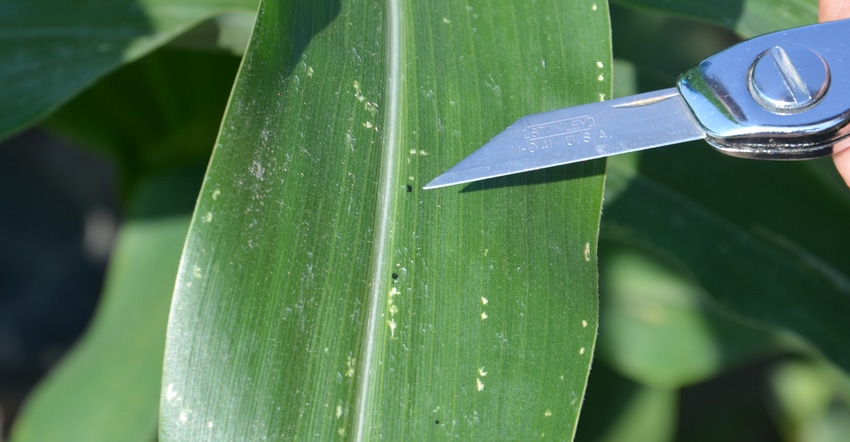
The telltale marks of flea beetle feeding stood out when Dave Nanda began looking at plants in the Corn Watch ’19 field earlier this summer. They looked like tiny scrape marks, sometimes lining up in a row. Then Nanda found the tiny insects themselves on a leaf, confirming what he suspected.
“The good part of this story is that flea beetle feeding on commercial corn usually isn’t a big deal,” says Nanda, director of genetics for Seed Genetics-Direct, Jeffersonville, Ohio. Seed Genetics-Direct sponsors Corn Watch ’19.
This corn, planted May 28, was at the seven-leaf stage when Nanda scouted it on July 2 and found flea beetles and evidence of flea beetle feeding.
“It’s not something you see every year, and it’s not an economic problem in commercial corn in most cases,” Nanda says. “However, this is a good example of why you should notice everything while you’re scouting fields, and then identify either lesions, feeding marks or insects, if you find them. You want to know whether what you’re finding is a problem or not.”
Flea beetle story
In this case, the minor damage and presence of the insect is worth noting, but not worth panicking over, Nanda says. However, in seed fields, it can become an issue.
According to the Purdue University Corn and Soybean Field Guide, if flea beetle feeding is an issue, it’s usually earlier in the season. They often attack seedlings. The guide provides treatment guidelines if an infestation is very severe. If there are five or more beetles per plant at the seedling stage, 50% of seedings are showing a silver cast and plants are under general stress, treatment may be warranted.
That obviously didn’t apply to seven-leaf corn. Nanda just noted what he observed.
Disease connection
The bigger threat, especially in seed fields or where corn may be susceptible, is that flea beetles can transmit a foliar disease called Stewart’s wilt, Nanda notes. It’s caused by a bacteria that can overwinter within the insect. Then when flea beetles feed during the growing season, they can transmit the bacteria to plants.
There are two phases to Stewart’s wilt. One phase attacks seedlings. The second phase appears as a leaf blight later in the season. It’s another foliar disease that can reduce leaf tissue area, limiting the plant’s ability to capture sunlight, complete photosynthesis and make sugar.
Because Stewart’s wilt is caused by a bacteria, not a fungus, fungicides aren’t effective against this disease, Nanda says. However, as noted earlier, it normally doesn’t cause economic concerns in commercial fields like the Corn Watch ’19 field. Where it might become a concern is in production of seed, where one or more inbred lines might be susceptible to the disease.
“We’re just highlighting discovery of flea beetles and symptoms of their feeding as a point of interest, and to make the case that not everything you find in the field while scouting is cause for concern,” Nanda says. “You need to identify what you find and separate what you should be concerned about from things which won’t affect yield or net return.”
About the Author(s)
You May Also Like




